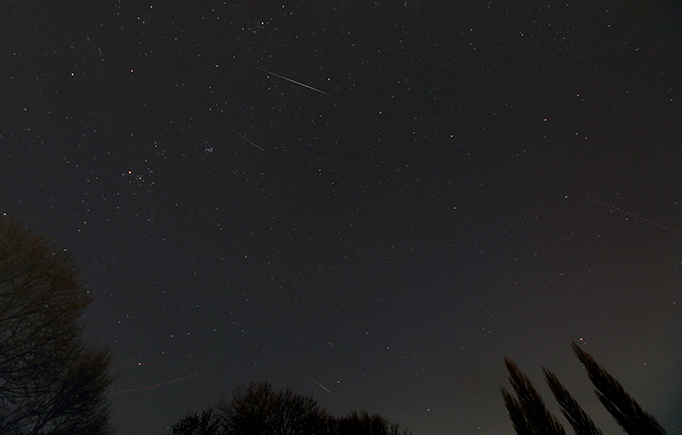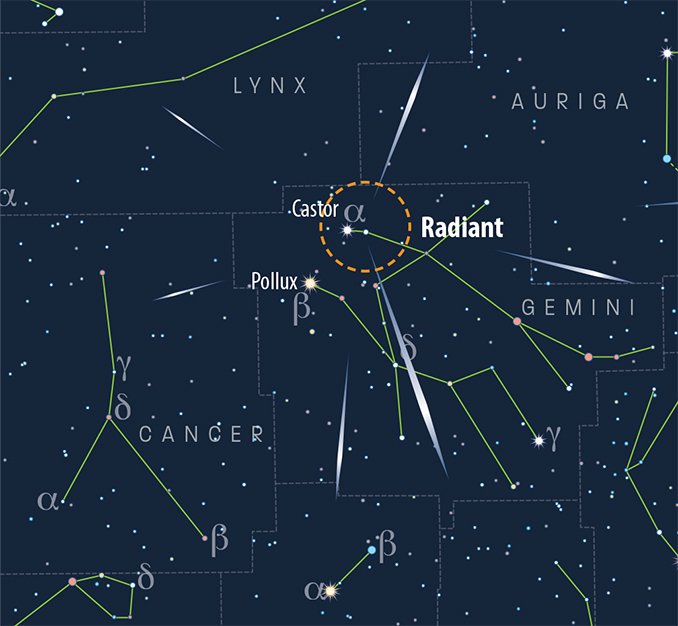The Geminid meteor shower peaks Sunday night (13 December), providing a great opportunity to witness the best meteor shower of the year. A meteor suddenly streaking across the sky is one of the most exciting sights in astronomy, but we can multiply that many times over by the assured prospect of dozens of shooting stars raining down from the Geminids over the course of the night! There’s even more good news as the show won’t be compromised by bright moonlight as it was in 2019, as the Moon is just hours away from its new phase.

Rates of meteors are predicted to reach a maximum at around 1am on 14 December, when the constellation of Gemini is well placed high up in the sky to the south. As many as 60–70 meteors per hour can be seen from the UK under clear and transparent skies, provided you are fortunate enough to enjoy dark skies where you live or can find a suitable observing site away from major sources of light pollution.
Meteor showers are seen when Earth encounters minuscule particles left behind usually by periodic comets; some of their material is ejected owing to surface heating that occurs on their repeated trips to the inner Solar System. Over time, particles are spread around the orbit of the comet, and when Earth’s orbit intersects this stream, particles enter the atmosphere and are vaporised, producing streaks of light. The Geminids are unusual in that the shower’s debris stream is shed not by a periodic comet but by the asteroid (3200) Phaethon.

Geminid meteors appear to originate from the Geminid radiant (the point in the sky from which the meteors appear to emanate when their paths are traced back). Naturally enough, it is found within the constellation of Gemini close to Castor (alpha [α] Geminorum, magnitude +1.6), the fainter, more northerly, of Gemini’s twins (the other star being Pollux [beta [β] Geminorum, +1.1). Gemini should be easy to locate owing to its bright twins, but if you’re unsure, then find brilliant and familiar Orion and then look about 30 degrees to the upper-right (north-east) of the magnitude +0.5 red supergiant Betelgeuse (almost 20 degrees separate Betelgeuse from magnitude +0.2 Rigel, Orion’s brightest star that lies at the bottom-right corner of its famous star pattern).
The Geminid radiant is well up in the eastern sky by 9pm and culminates (its highest point due south) at about 2am at a very favourable altitude of 70 degrees.

When looking for meteors, rather than peering intently directly at the radiant, look some 30 or 40 degrees away, where the meteors will appear brighter. Orion and Taurus are profitable areas to the west, with Cancer and Leo to the east.
If you are observing from a suburban site, try to keep major sources of local light pollution out of your direct view, as you’ll see more shooting stars if you can become dark adapted and stay that way throughout your meteor watch. Geminid meteors, produced by robust material shed by (3200) Phaethon, are slow moving (entering Earth’s outer atmosphere at a relatively slow 35 kilometres per second), and are renowned for producing a good proportion of bright and colourful shooting stars, capable of punching through a moderately light-polluted sky, and they often produce persistent trails (or trains) that can fragment.
So, if you’re going to head out into the crisp December night for an extended watch, remember to wrap up warm and bring along a warm drink and a snack or two. Then get comfortable and enjoy the show!
